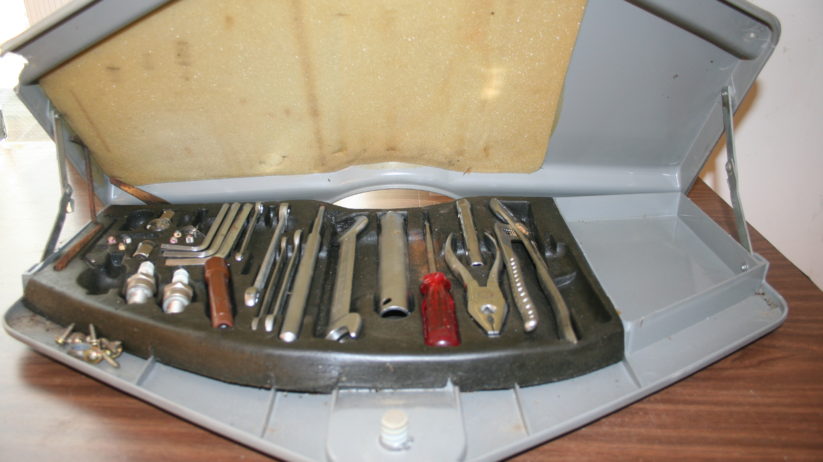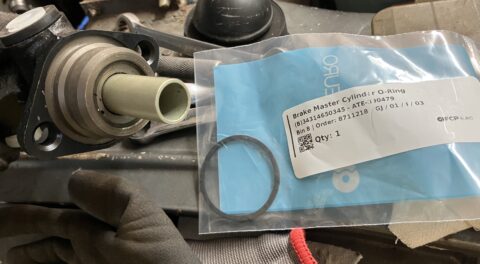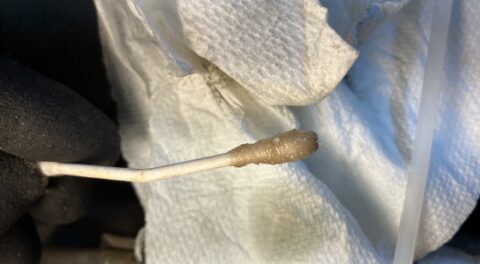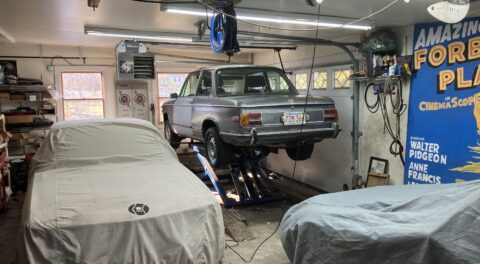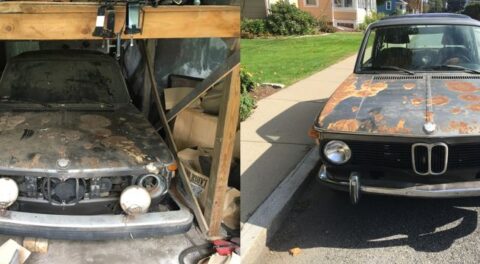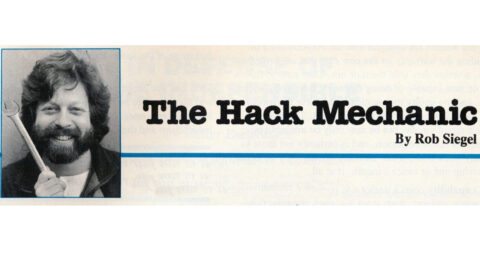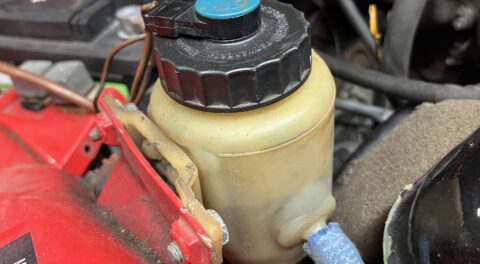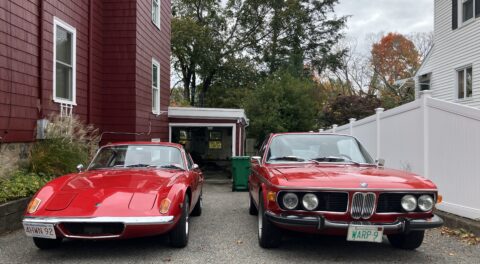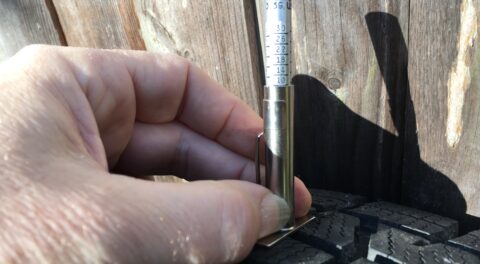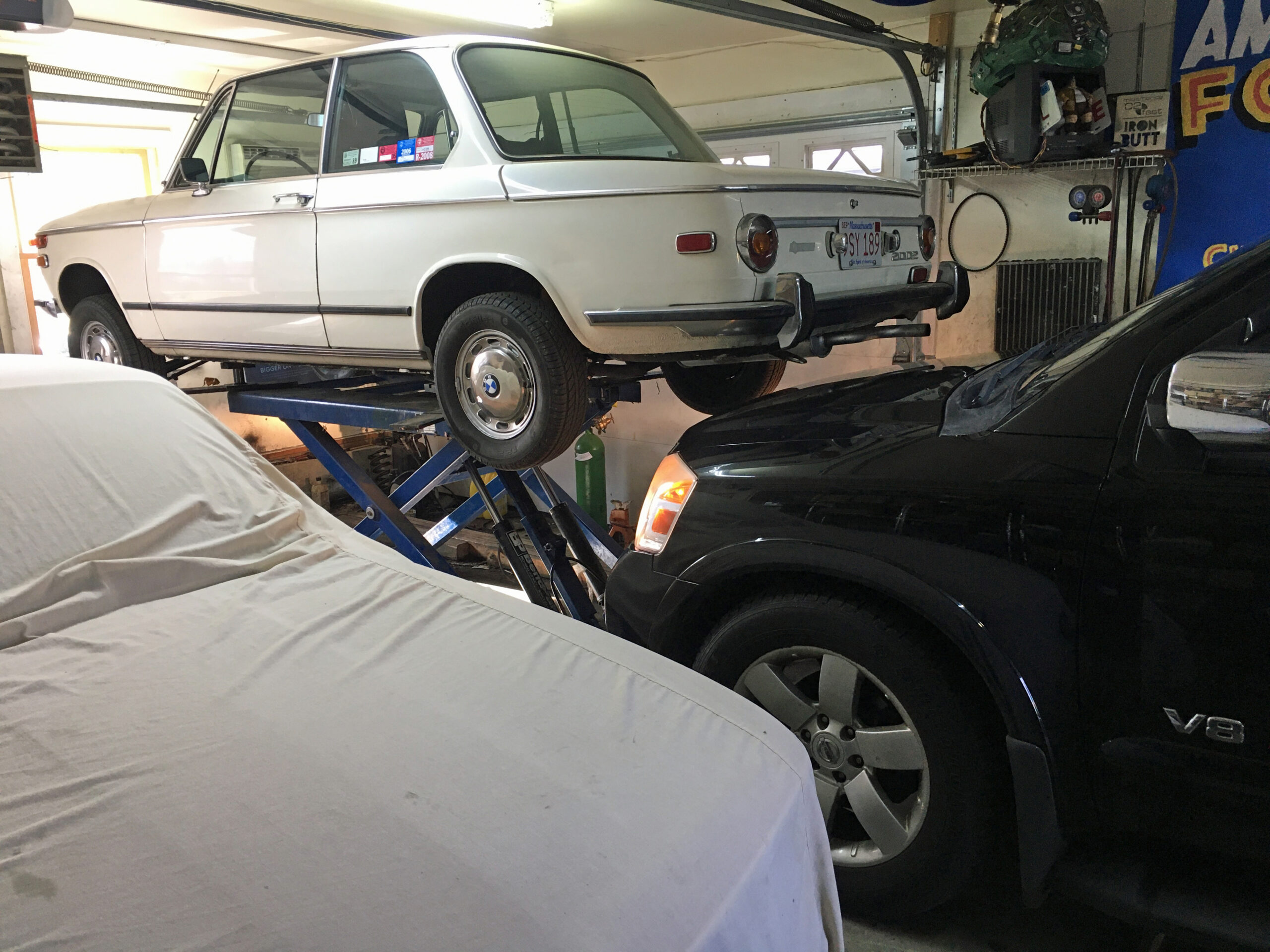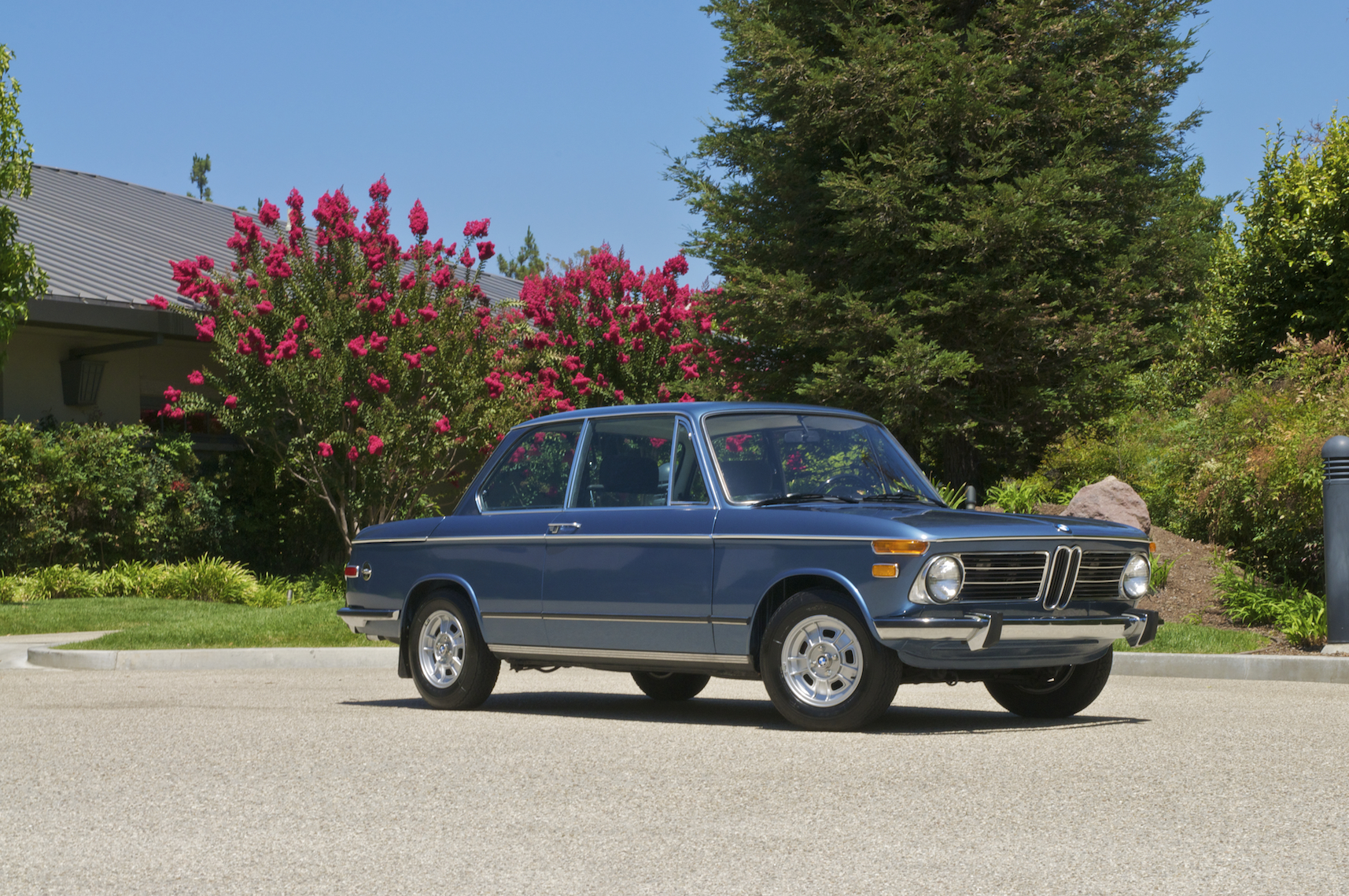A few weeks ago, a ’74 Bavaria out in Agawam, Massachusetts, showed up in a Craigslist search. The ad said that the car ran, but mentioned that it had “some rust.” The car didn’t have a lot of curb appeal in the ad: The photos showed that (a) it was a big-bumper car, (b) the front bumper had been removed but the hydraulic mounts were sticking out of the nose, which is never a good look, and (c) the front bumper was sojourning in the passenger compartment, which is a just plain weird way to photograph a car.
I texted the seller, asked about the rust, and he sent me a photo showing holes in the floor. At the $2,950 asking price, there was no upside in it for me.
I thought that was that.
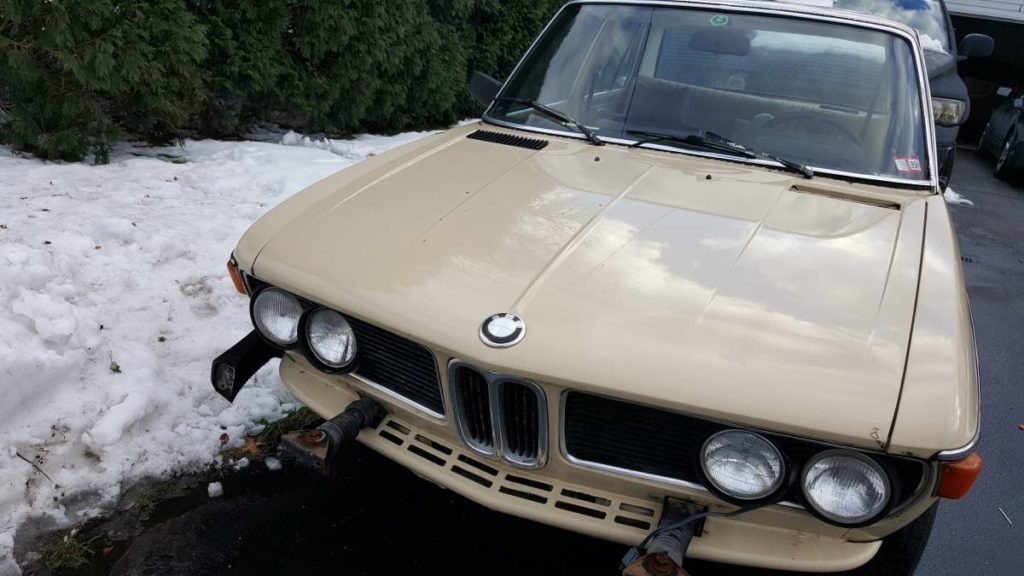
The bumper-less look rarely works for me.
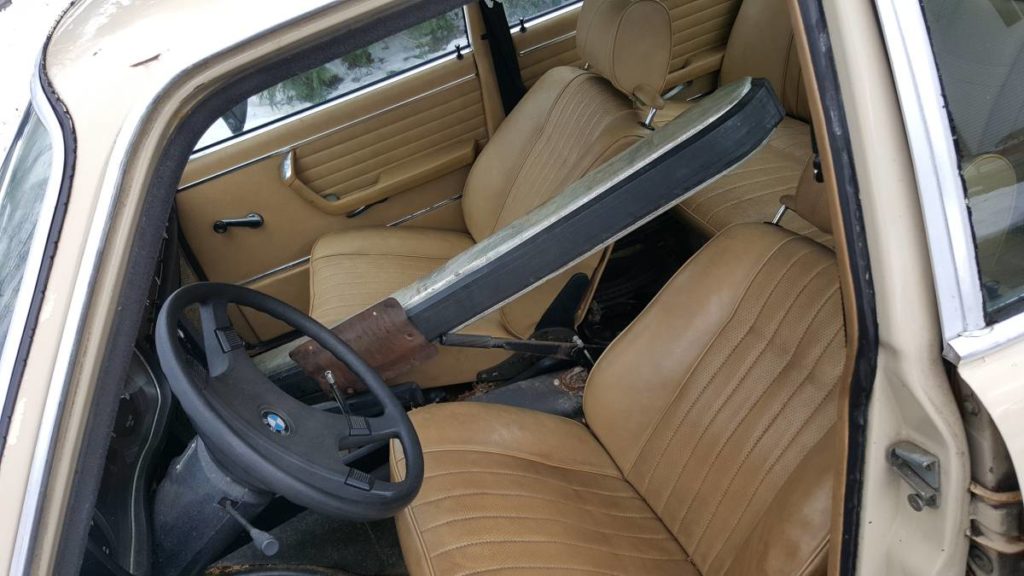
The bumper-in-the-passenger-compartment look works for me even less.
But over the next few weeks, the seller kept dropping the price. When it reached $1,650, the car again caught my attention. The front seats did look in great shape, but that’s not a good enough reason for me to buy a car. As I’ve said before, I really can’t have parts cars on my property. There basically is no property except the driveway, and there’s no room for them in the driveway.
And then, as I looked at the photos more carefully, I saw what appeared to be a fully-populated tool tray.
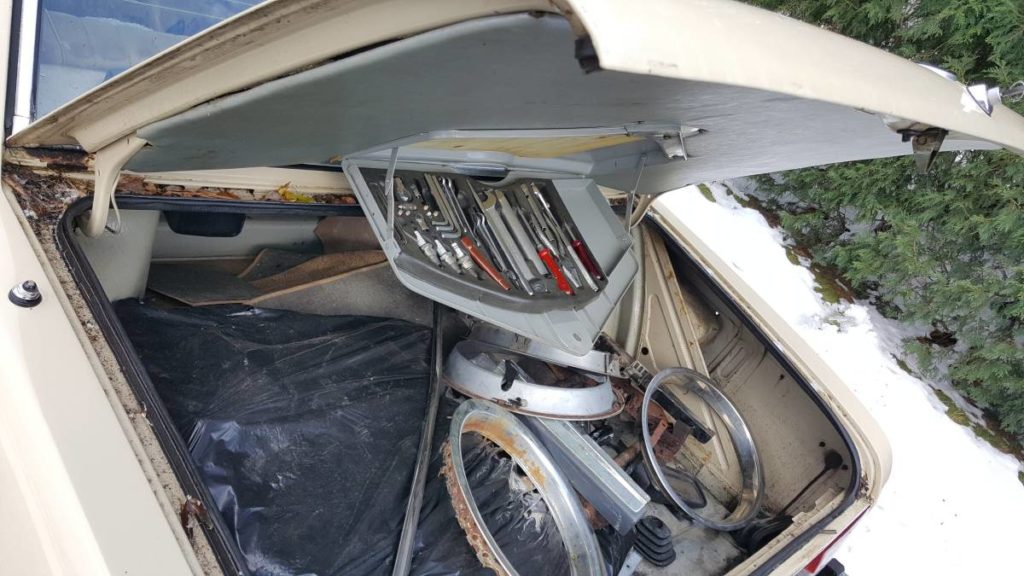
Schwing!
If you don’t know, the E3 (Bavaria) sedan shares the tool tray with the E9 (3.0CS) coupe, and fully-populated, intact tool trays in excellent condition are coveted items. The tool tray is essentially a plastic clamshell: The upper part screws to the underside of the trunk lid, allowing you to fold down the lower part and access its contents. As is the case with other 45-year-old plastic on these cars, age makes the tray brittle; it cracks easily with the weight of the tools it’s meant to carry.
When I bought my 3.0CSi 33 years ago, it had a largely intact tool tray, but when I had the car repainted in 1988, all of the panels on the underside of the trunk lid, including the tool tray, were removed. Somewhere in the maelstrom of my garage and my basement—really, my life—the tray was misplaced. I found it last year, but it had gotten batted about, was cracked beyond use, and the tools were gone. I had a vague memory of taking the tools out, but I had no idea where they were.
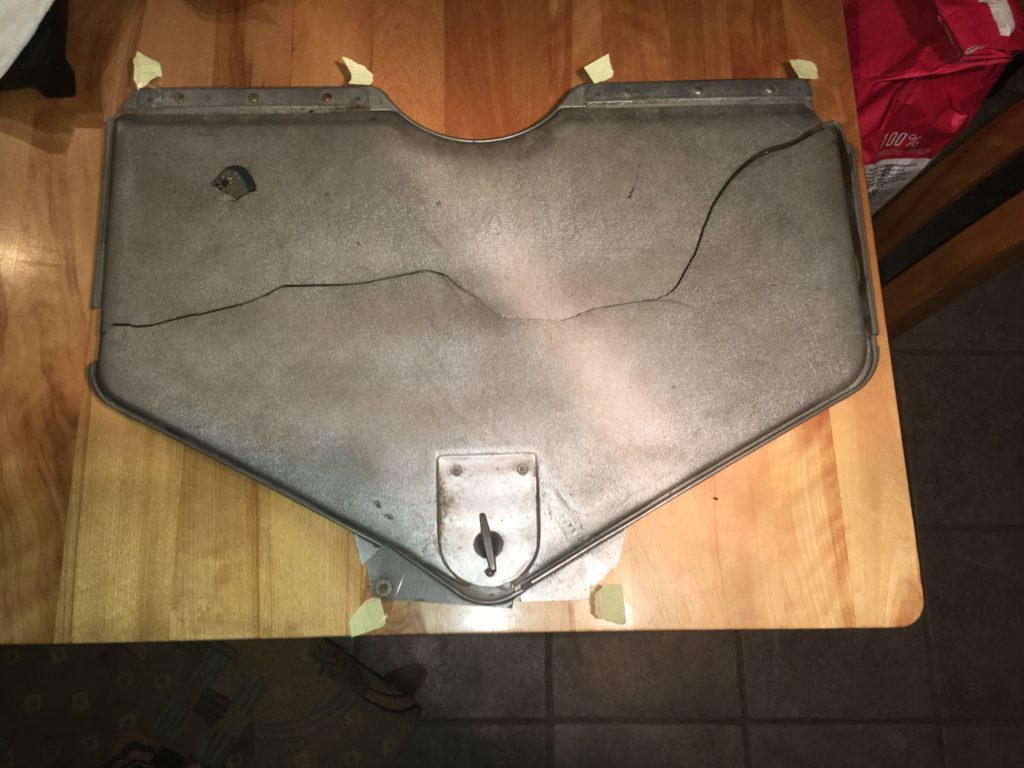
My 3.0CSi’s original tool tray is a goner.
The plastic tool tray itself had been unavailable from BMW for decades, making good un-cracked trays valuable. When they showed up on eBay, they frequently had asking prices over $500. Articles were published about using epoxy and paint to repair and refurbish old trays.
Then, a few years back, BMW commissioned a new batch of trays. 71111102916 is the part number for the tray and the foam insert that holds the tools. The list price is $470. Due to both the plastic being new and a reported beefing up of the tray, the new trays are supposedly more robust than the old ones. Anyone who was sitting on an old tray waiting for the prices to continue rising probably feels that they mistimed the bubble.
But even if you get hold of a good tray, that doesn’t get you the tools. Realoem shows 71111115329 as the part number for the “tool kit,” but it’s only a subset of what’s supposed to be in the tray—just the Heyco-brand wrenches, screwdrivers, and pliers. And those new Heyco screwdrivers have green handles; the originals that had translucent red handles are now very sought-after. I’ve seen people asking $150 each—for a screwdriver. (Don’t believe me? Check here.)
And you still need the Allen keys and feeler gauges and the spare parts like the plugs, spark-plug connector, and bulbs. And the twin cherries on the tool-kit sundae: the power-window-helper tool (a piece of toothed plastic to help open the windows if the power motor fails) and the blue BMW-logo cleaning cloth.
Now, historically, whenever I’ve even named those last two items, I’ve burst out laughing. I never have subscribed to the idea that cars are like the object in the Doctor Who episode “The Key To Time,” where once all the pieces are assembled, it glows and is imbued with special powers. I do get that as cars like the E9 have become more valuable, with nicer examples breaking six figures, a complete, intact tool kit can be an item that allows the value of the car to do the whole-is-bigger-than-the-sum-of-the-parts thing. But my E9 isn’t of that caliber, and I’m not “that guy” who bugs people with inane conversations about esoteric parts, thinking that procuring them will make him happy. So whenever any E9 conversation veers off into discussion of the power-window-helper tool and the blue cloth, I just need to excuse myself, smear some grease on my face, and go do something useful. Or at least handle a giubo.
And yet, with my E9 having had a tool-tray-shaped hole in its inner trunk lid for over 30 years, and a photo in a Craigslist ad taunting me from my computer screen… yeah, I started to be interested enough in this Bavaria’s tool tray to do something about it.
I texted the seller and pulsed him on the idea of selling me the tray and tools, offering to give him some cash and substitute my badly-cracked tray so that there wouldn’t be a gap on the underside of his car’s trunk lid. Initially, he showed little interest, saying that he just wanted to sell the whole car, but when the car was still unsold in the New Year, he asked me what kind of money I was talking about.
I knew that the tray and tool kit had value, and wasn’t looking to take advantage of the seller. I recalled seeing a non-mint E9 tray with an incomplete set of tools on eBay a few months back with a $500 asking price, but I didn’t know if it sold, and I couldn’t find it under “completed auctions.” I thought about it, and told him I’d drive out there (Agawam is only about an hour and a half from me), and if the tray was un-cracked and the kit was complete, I’d unscrew the tray, substitute my old cracked one, and put $300 in his hand.
“Three hundred bucks?” he replied. “These things are worth that much?!”
Surprisingly, for someone so astonished at an offer, he didn’t take me up on it. He continued to say that he wanted to sell the whole car.
Later that night, I searched online for “BMW E9 tool tray,” and my jaw dropped when I found this Bring a Trailer auction from November, where a concours-condition tool tray, complete except for the window-helper tool and blue cloth, sold for the nosebleed value of $2,100. On the one hand, I make a career out of sharing information, telling a seller exactly what I know about the value of whatever he or she is selling; on the other hand, this wasn’t something that I was going to re-sell, it was something I wanted for my own car. I wasn’t sure that I had a moral obligation to explain everything I knew about red-handle screwdrivers and disclose some wild upper-end point of a mint kit’s market value.
I decided to keep mum about the BaT auction, both because the seller could Google “BMW E9 tool tray” just as easily as I just did, and because I recalled an episode of Chasing Classic Cars where Wayne Carini said that much of his time is spent explaining to people why, for example, their barn-find VW Bus isn’t worth the three hundred grand that the dead-mint fully-restored one just sold for at Barrett-Jackson.
Really, it didn’t much matter what the mint tool tray on BaT had sold for. In an environment where, at long last, I’m putting my Lotus Europa’s engine back together and it’s making a big sucking sound in my bank account, $300 is what I was willing to pay.
I didn’t hear back from the seller for a few days. When I did, he still really wanted to sell me the whole car. At one point he sent me a video of the engine running, and offered me the car, delivered to my door, for a thousand bucks. I was tempted, but even at a grand, I didn’t see any upside in the car as a project, and I didn’t need an M30 engine or want a parts car. I held fast on my offer to drive out, give him $300, and swap trays.
A few days later the seller contacted me. He said that he had two people coming to see the car, and wanted to see what they’d offer with the tray in it, but he also asked me if I’d be willing to bump up my offer. I said that it depended on the condition of the tray, whether both the lower and upper parts of the clamshell were un-cracked, and whether it really was complete. He sent me a photo showing that, when the tray was lowered, some small cracks could be seen in the upper section where it attached to the trunk lid.
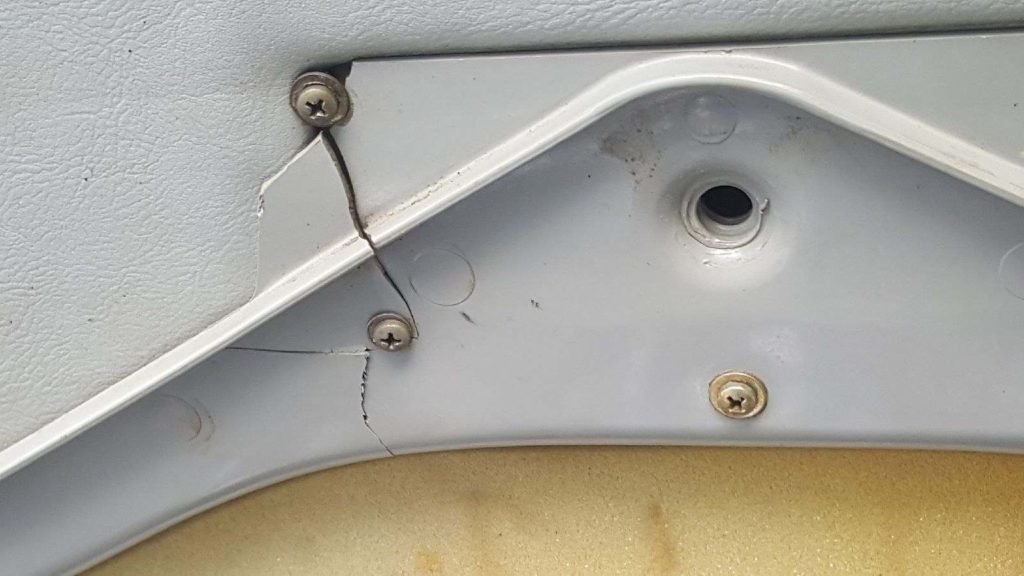
The upper part of his tray was cracked.
The fact that the tray had cracks in it deflated my interest somewhat. And then I looked carefully at the photo in the CL ad, and noticed that the two red-handled screwdrivers were different colors. I asked the seller to send me a closeup.
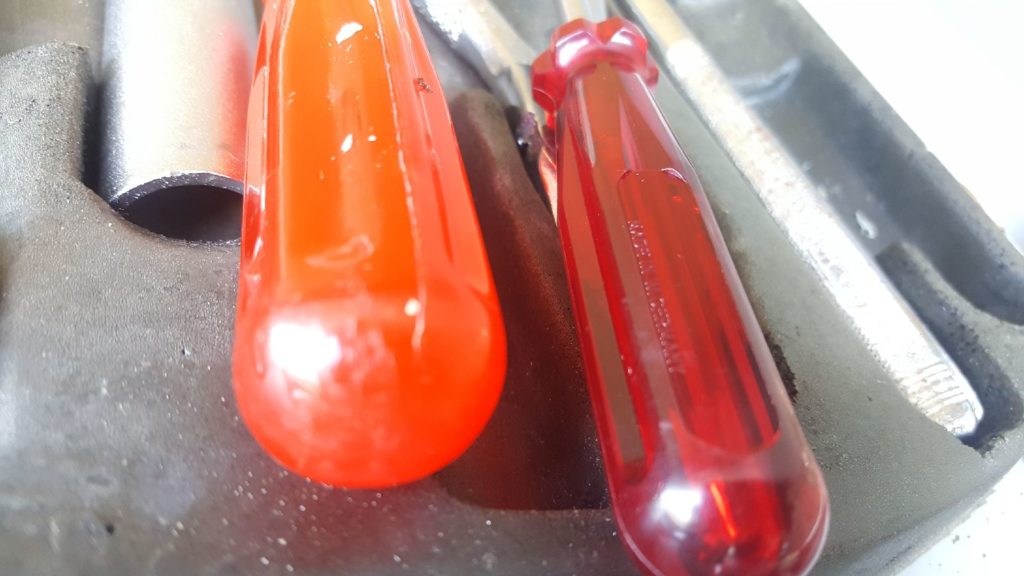
The left one: Heyco or not?
The smaller one on the right was clearly a correct red-handle Heyco screwdriver. It had the right color and translucency, and the “Made in Germany” lettering was visible. The one on the left, however, looked odd. I asked him if he could look for the white-lettered “Heyco” label or “Made in Germany.” He said he didn’t see either. Was it original? Maybe.
There are only so many times you can ask people to check small things like this without turning into “that guy.” I explained that the value of the kit was in its condition, completeness, and originality, and said that I was still willing to drive out there and look at it, but could no longer promise to give him $300 sight-unseen.
And, with that, the deal fell apart. The seller said, “I’m just going to sell the whole car right now.” And apparently he did, because shortly after, the ad was off CL.
Part of me thought, “IDIOT! You should’ve make this happen!” But the larger part of me was relieved at not spending three hundred bucks and traveling the better part of a day for something I not only didn’t need, but had happily lived without for over 30 years.
And then something funny happened.
The odd pentagonal shape of the tool tray triggered a memory, like the mashed-potatoes scene in Close Encounters (“This is important… this means something…”). It ricocheted around in my brain and settled on—Bertha. Wait, what? Yes, that’s correct; I looked through the photos I took of Bertha the 2002tii when I excavated her from Alex’s neighbor’s garage, and found what I was struggling to remember.
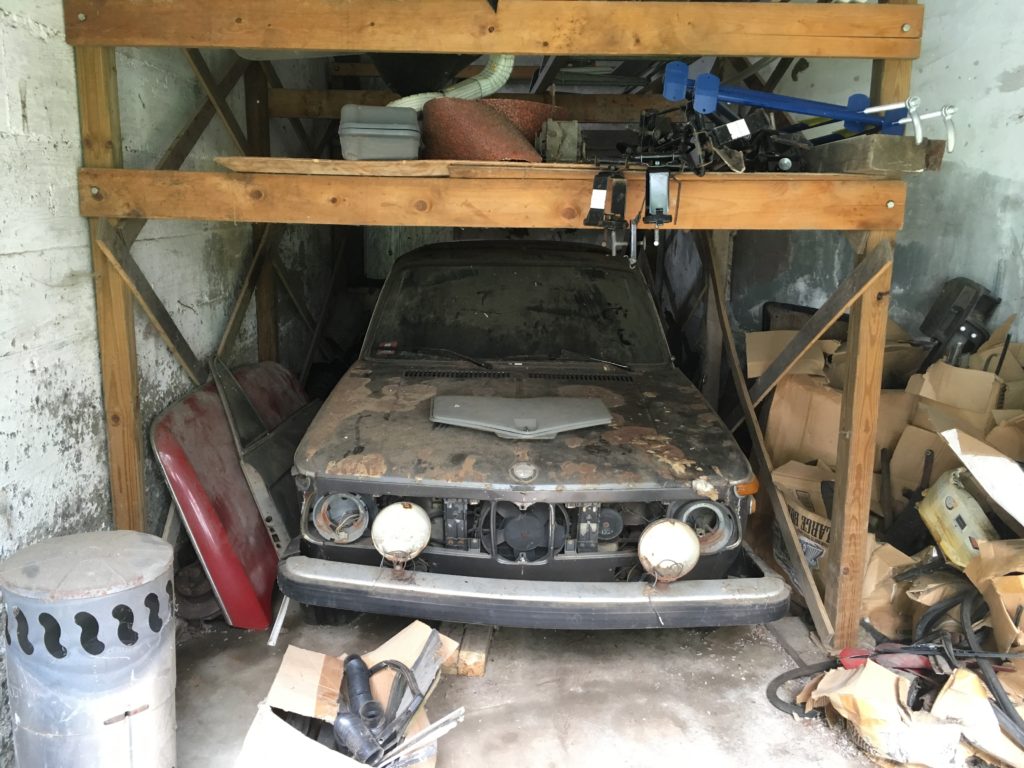
Bertha posing with a tool tray that had kept her company for decades.
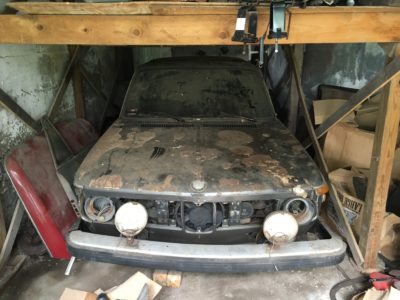 Bertha spent 26 years surrounded by boxes of parts. Most of it was junk. This summer, while sorting through them after I agreed to buy the car, I found a tool tray from a Bavaria that Alex had parted out decades ago. I’d taken the tray out of the dilapidated cardboard it was sitting in and put it on Bertha’s hood so that it wouldn’t get damaged when I began consolidating the boxes. Then I realized that I should document the scene before I moved anything. This was the very first photograph I took. I then realized that the tool tray was on the hood, moved it, and took the photo that was in the first piece I wrote about resurrecting Bertha.
Bertha spent 26 years surrounded by boxes of parts. Most of it was junk. This summer, while sorting through them after I agreed to buy the car, I found a tool tray from a Bavaria that Alex had parted out decades ago. I’d taken the tray out of the dilapidated cardboard it was sitting in and put it on Bertha’s hood so that it wouldn’t get damaged when I began consolidating the boxes. Then I realized that I should document the scene before I moved anything. This was the very first photograph I took. I then realized that the tool tray was on the hood, moved it, and took the photo that was in the first piece I wrote about resurrecting Bertha.
So I already had another tool tray. I’d forgotten all about it! Although I hadn’t stashed it with the rest of the 2002 stuff I’d hauled back from Alex’s, it didn’t take me long to find it. The front corners were broken (the same area where the seller’s one was cracked), but the rest of it was pretty solid, certainly way better than the E9’s original tray. And, when I opened it up, I found most of a set of tools and parts inside.
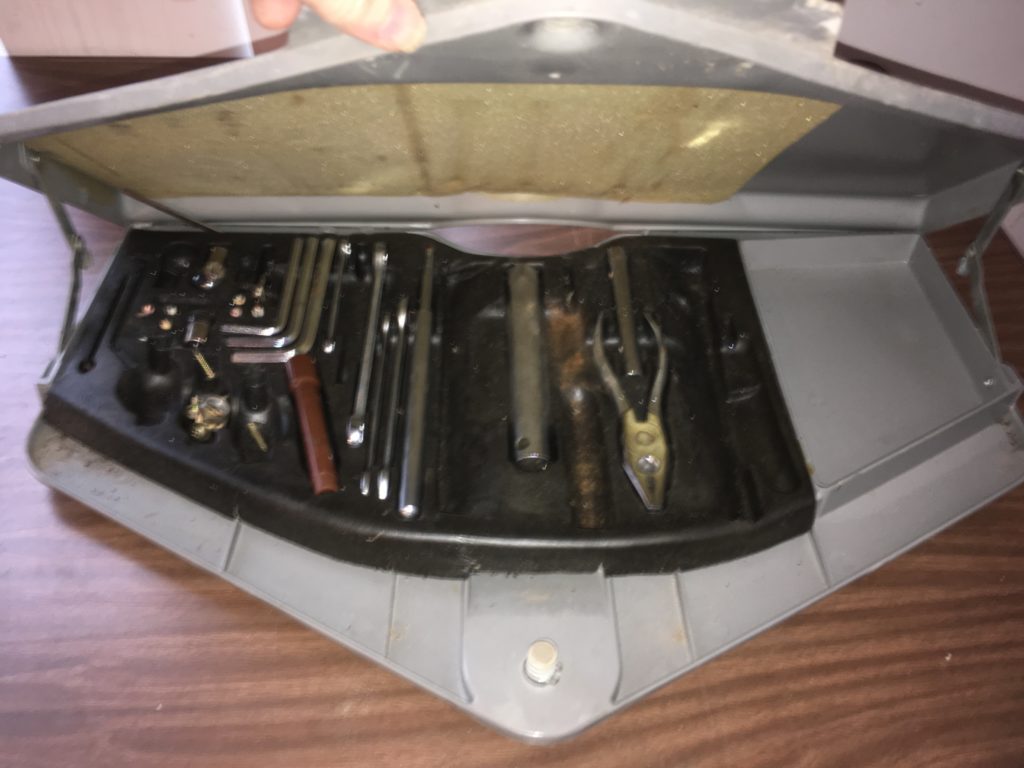
It’s amazing what you forget you already have.
I then rooted around in the garage a bit, and discovered a cardboard box in which were some of the E9’s original tools, plus some other Heyco tools from random BMW tool kits. It’s incomplete, because some of the more commonly-used wrenches, like the 10-mm and 13-mm, live on the back floor of some of the cars, but it had the pliers that were missing. It even had some original spare spark plugs in it.
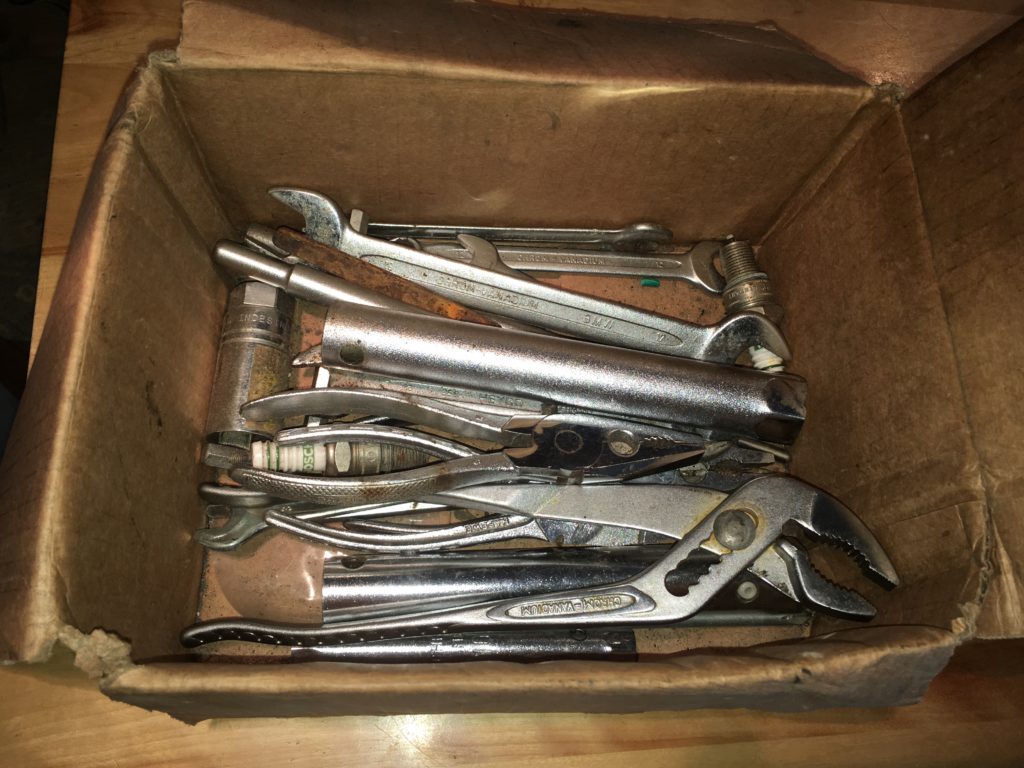
I found more of the AWOL Heyco tools.
Finally, I made a push to see if I could find my red-handle screwdrivers. I recalled seeing the smaller one within recent memory; it was even possible that it was lying on the back floor of one of the cars, or was with the tools that are in the trunk of Louie in the BMW CCA Foundation museum. I came up empty. But then, in an incredible coincidence, I was rooting around in the basement among old painting supplies, and found the long red-handle screwdriver sitting among the paint cans. I’d apparently last used it decades ago to pry open a can of house paint, some of which can be seen on the handle.
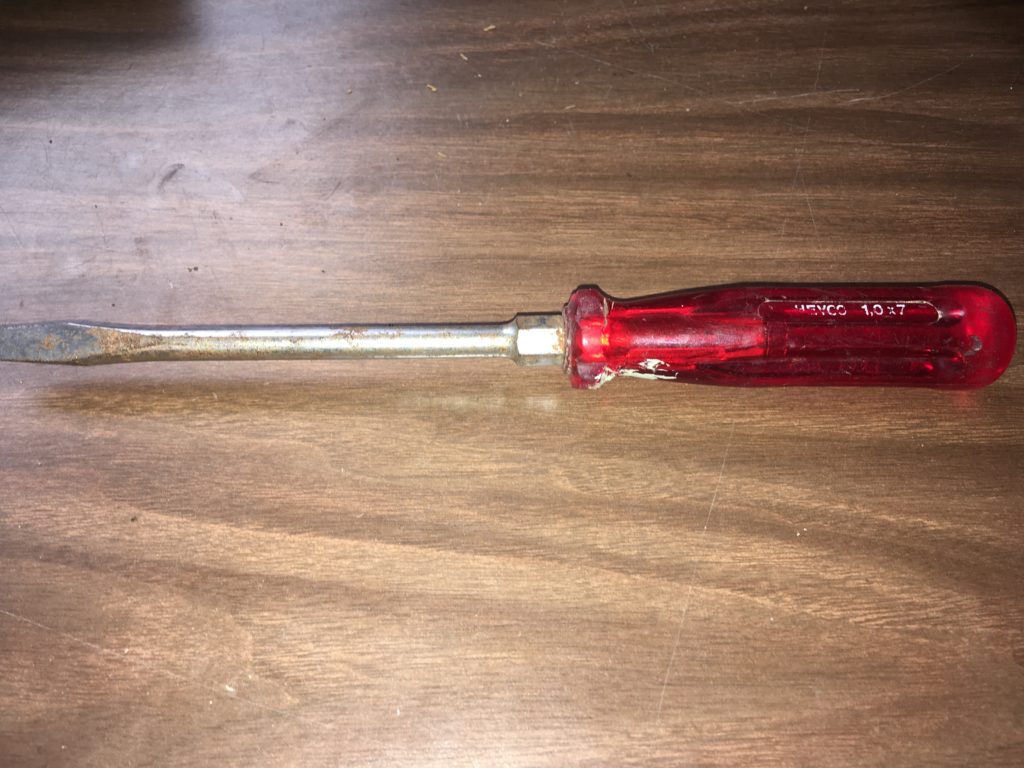
Lookie what I found!
Putting it all together, the tool tray and kit now looks like this. And it cost me nothing, because I already had everything that’s in it.
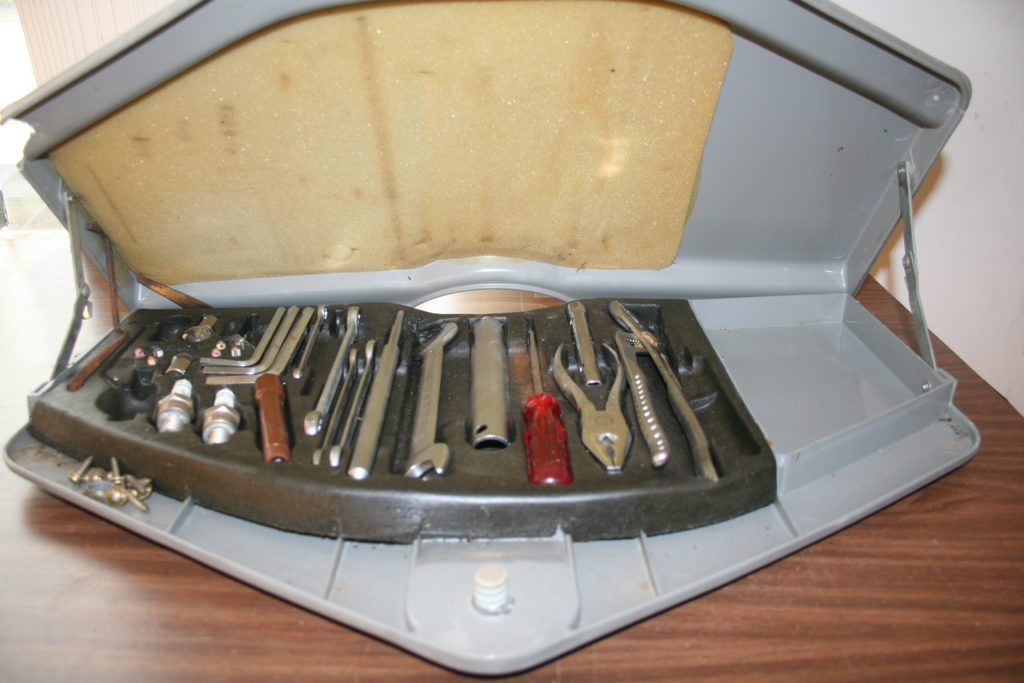
Not bad, eh?
I’m actually looking forward to finding the handful of missing tools and parts, completing the kit (well, largely), and installing it back into my E9, even if it won’t glow like the Key To Time in that Doctor Who episode.
But if I start yammering about blue cloths and plastic window tools, just slap me. I don’t want to become “that guy.”—Rob Siegel
Rob’s new book, Just Needs a Recharge: The Hack MechanicTM Guide to Vintage Air Conditioning, is available here on Amazon. His previous book Ran When Parked is available here. Or you can order personally inscribed copies of all of his books through Rob’s website: www.robsiegel.com.

